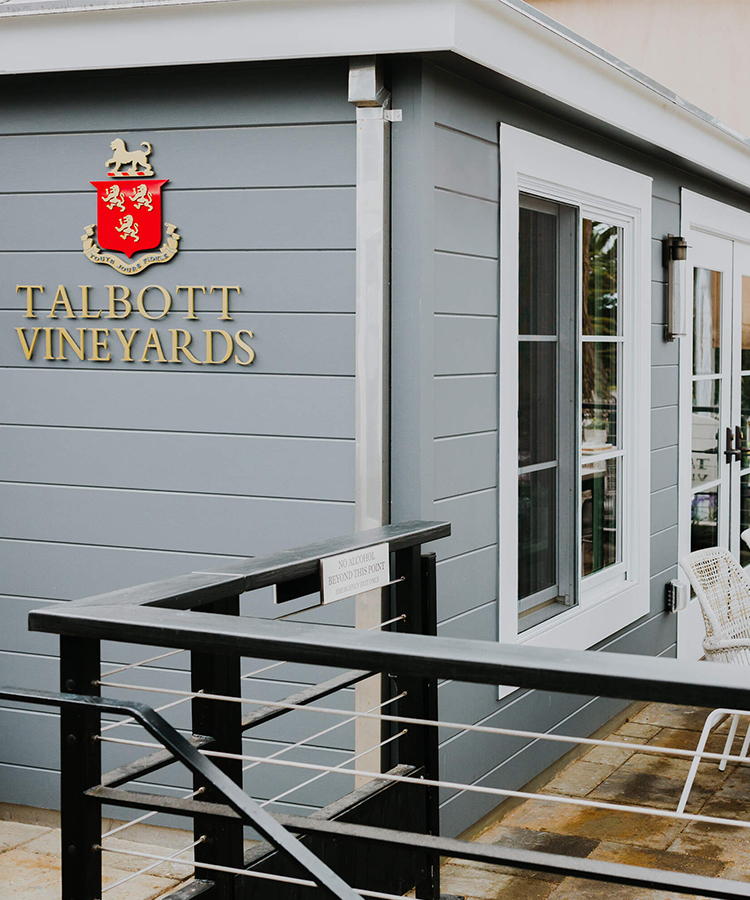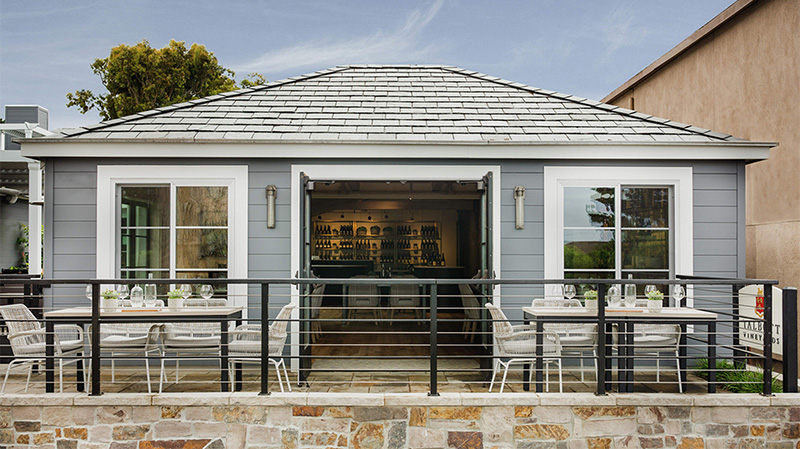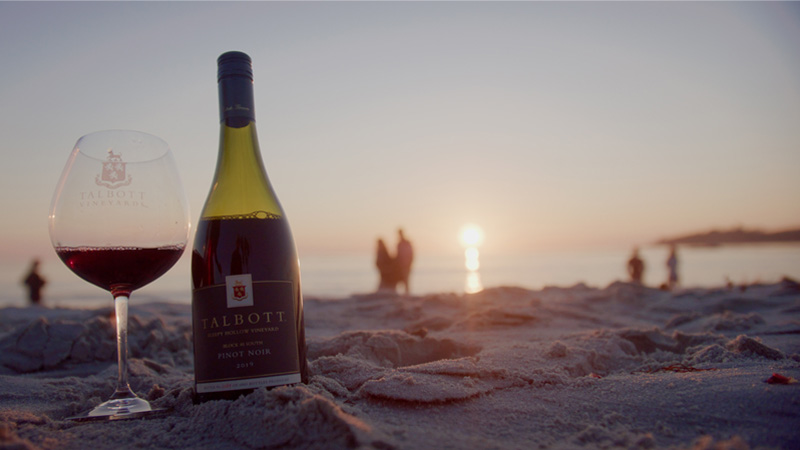
California’s Carmel-by-the-Sea isn’t just any seaside destination. The idyllic town on the Monterey Peninsula is one of the most famous on the West Coast, prized for its serenity, its pristine beaches, and the creative atmosphere that has enticed famous poets, authors, and actors alike. Rumor has it that Robert Louis Stevenson drew inspiration from his time in Carmel when he wrote “Treasure Island.” Clint Eastwood, maybe its most famous resident, was even mayor for a term in the late 1980s.
But Carmel isn’t just about fame. It’s about celebrating and quietly cultivating an unmatched atmosphere, one where interesting people mix with talented creatives, and where, with more restaurants per capita than any other small town in America, it’s easy to raise a glass and celebrate what a singular place Carmel is. One of the best places to celebrate the town’s unique character is Talbott Vineyards’ new tasting room, where the natural beauty of its surroundings in the heart of Carmel-by-the-Sea combines with decades of winemaking expertise in the Santa Lucia Highlands AVA.
The airy space of the tasting room lets in sea breezes and has an outdoor patio where you can enjoy the scenery while you sit and sip. But there’s one thing even better than the view: the wine. The winery’s location, growing conditions, and winemaking ethos contribute to vintages that are at once robust and delicate, complex and yet easy to drink, which have brought in some of the world’s most prestigious accolades.
“Talbott Vineyards is one of the original wineries to discover the Santa Lucia Highlands’ potential for growing exceptional Chardonnay and Pinot Noir grapes,” says Kamee Knutson, winemaker at Talbott. “In 1991, Talbott’s founder, Robb Talbott, was instrumental in helping establish the Santa Lucia Highlands AVA.”
Talbott’s Chardonnay and Pinot Noir are all estate-grown within 20 miles of Monterey Bay in the Santa Lucia Highlands, about two hours south of San Francisco and just over the mountains from Big Sur.
The winery owns two vineyards in the Highlands, which has a unique advantage in being a high-elevation area close to the ocean. One of the winery’s growing locations, Sleepy Hollow Vineyard, is a grand cru vineyard, as designated by “Wine Enthusiast” in 2016.
“Sleepy Hollow Vineyard is a unique California treasure,” Knutson says. The deep marine influence of salt air and cool temperatures on the grapes allows for some of the longest vine ripening in the state. “As the inland temperatures rise, cool air rolls off the Pacific Ocean with wind and marine fog virtually every day,” she explains. “It’s not unusual for Sleepy Hollow Vineyard to have a 40-degree temperature swing from the daytime high to the nighttime low.” Those conditions are ideal for growing Chardonnay and Pinot Noir, especially since the extended time on the vine allows full phenolic ripening.
Those conditions are part of what allowed Talbott to create the Sleepy Hollow Chardonnay that Wine Spectator rated as a 100-point vintage in 1990. Considering that the vast majority of 100-point ratings go to reds, that’s an exceptional honor. “Sleepy Hollow is famous for producing low yields of richly concentrated berries with a signature minerality,” Knutson says. “Our Chardonnay tends to be complex and bright while [the] Pinot Noir boasts deep red-fruit characteristics.”
But it’s not just the land. It’s how the land is cultivated and guided, stemming from decades of working there. “Because of our deep knowledge of the vineyard, we know which varieties and clones thrive in specific blocks,” she adds. “We harvest and vinify blocks separately, which gives us tremendous advantages in blending to deliver complex layers of flavor.”
Talbott produces Chardonnay from its Sleepy Hollow and Diamond T vineyards, and smaller production lots from different blocks of vines. The beauty of a visit to the tasting room in Carmel is that you can enjoy wines from those individual blocks and really taste the differences that just a few acres make. The Sleepy Hollow Block 4 North Chardonnay, for example, is a surprisingly delicate and deceptively complex white, which has subtle top notes of tart tropical fruit and a tiny bit of balanced oak. The Sleepy Hollow Block 50 South gives off honeysuckle and Mandarin aromas with a toasty, more oaked finish. In addition to the block-specific wines, Talbott’s winemaker, Kamee Knutson, crafts the Fidelity Chardonnay, which is the pinnacle of its portfolio, showcasing the best barrels of the vintage from Sleepy Hollow Vineyard.
The same goes with the Pinots: Small differences in location yield enormous differences. Sleepy Hollow Block 22 West Pinot Noir is a medium-bodied red that has rose and jasmine top notes with a delicate, earthy finish. The Sleepy Hollow Block 23 West is a bigger, riper Pinot Noir, with complex, dark berry notes and an oaky finish. And they all come from the same place, just a few hundred acres apart.
“Because our Sleepy Hollow Chardonnay and Pinot Noir grow on the property with our winery, there is no time lost,” Knutson explains. “We are able to maintain the quality of the grapes being received while preserving the complexity and texture of the fruit. We keep the blocks separated from the beginning to truly evaluate the flavor characteristics of each block.”
It’s wine made by people who truly care about wine, but who also truly care about the place it comes from.
“With the exceptional quality Chardonnay and Pinot Noir Sleepy Hollow produces vintage after vintage, we consider it our responsibility to act as stewards of the land,” Knutson says. The certified-sustainable vineyard is solar-powered and closely manages water usage, re-using treated water for irrigation only when soil probes indicate the vines need water. “Sustainability is about preserving the vineyard for future generations – a philosophy we take seriously,” she adds. “Our best years are yet to come,” Knutson says. “We believe our best wines are in front of us.”
The wines they’re making today, though, are exceptional. Reserve your spot at Talbott’s tasting room to experience them for yourself!
This article is sponsored by Talbott Vineyards.




